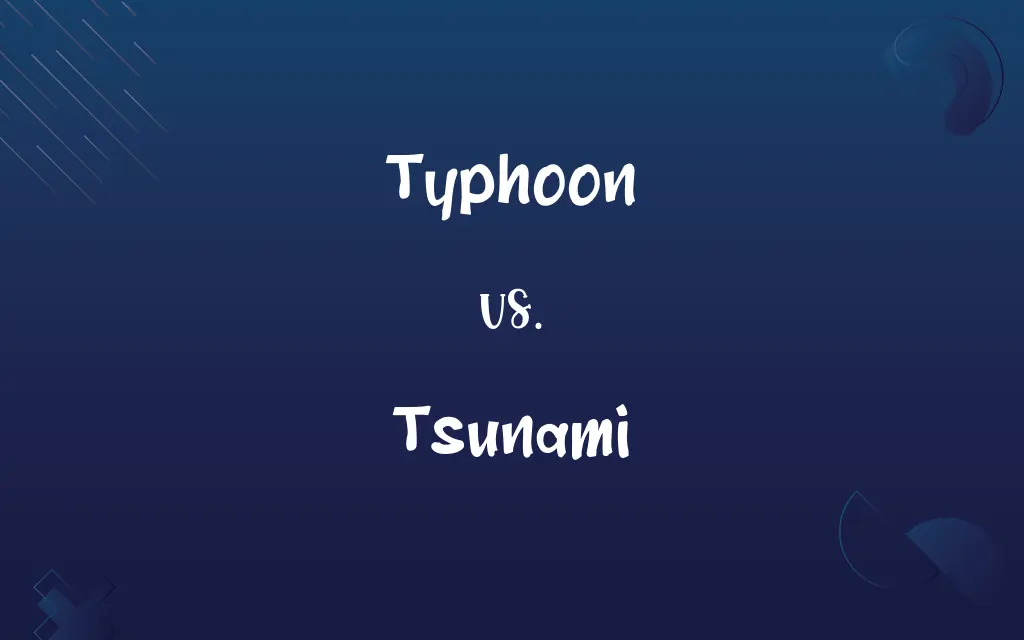Typhoon vs. Tsunami: Know the Difference

By Shumaila Saeed || Updated on December 29, 2023
A typhoon is a large tropical storm in the Northwest Pacific Ocean, characterized by high winds and heavy rain; a tsunami is a series of ocean waves caused by underwater seismic activity.

Key Differences
Typhoons, specific to the Northwest Pacific, are powerful tropical cyclones, while tsunamis are large ocean waves triggered by underwater earthquakes or volcanic eruptions.
Shumaila Saeed
Dec 29, 2023
Typhoons form over warm ocean waters and involve atmospheric phenomena, whereas tsunamis are primarily caused by seismic events like earthquakes.
Shumaila Saeed
Dec 29, 2023
The primary danger of typhoons is high winds and heavy rains causing floods and damage, while tsunamis pose risks with their powerful and sudden waves impacting coastlines.
Shumaila Saeed
Dec 29, 2023
Typhoons can be tracked and forecasted using meteorological data, but tsunamis, though detectable, often provide less time for warnings.
Shumaila Saeed
Dec 29, 2023
The scale of a typhoon is measured by wind speed and atmospheric pressure, whereas a tsunami is measured by wave heights and seismic activity.
Shumaila Saeed
Dec 29, 2023
ADVERTISEMENT
Comparison Chart
Primary Cause
Atmospheric conditions over warm waters
Underwater seismic activities
Shumaila Saeed
Dec 29, 2023
Warning Systems
Meteorological tracking and forecasting
Seismic monitoring, limited warning time
Shumaila Saeed
Dec 29, 2023
ADVERTISEMENT
Typhoon and Tsunami Definitions
Typhoon
A severe tropical storm characterized by high winds.
They evacuated the area in anticipation of the approaching typhoon.
Shumaila Saeed
Dec 29, 2023
Tsunami
A catastrophic ocean wave event following an underwater quake.
Tsunami alerts were issued across the Pacific after the undersea quake.
Shumaila Saeed
Dec 29, 2023
Typhoon
A powerful storm with torrential rain and strong winds.
The typhoon brought heavy rains that led to flooding.
Shumaila Saeed
Dec 29, 2023
Tsunami
A series of large ocean waves caused by seismic activity.
The earthquake triggered a devastating tsunami.
Shumaila Saeed
Dec 29, 2023
Typhoon
A tropical cyclone in the Northwest Pacific Ocean.
The typhoon caused widespread damage along the coast.
Shumaila Saeed
Dec 29, 2023
ADVERTISEMENT
Tsunami
A high-energy wave train originating from underwater disturbances.
Coastal towns were evacuated following a tsunami warning.
Shumaila Saeed
Dec 29, 2023
Typhoon
A cyclonic storm occurring in the western Pacific region.
The fishing fleet was caught off-guard by the sudden typhoon.
Shumaila Saeed
Dec 29, 2023
Tsunami
Oceanic waves produced by volcanic eruptions or earthquakes.
The tsunami washed away several homes along the beach.
Shumaila Saeed
Dec 29, 2023
Typhoon
A natural disaster with intense wind and rain.
Relief efforts began immediately after the typhoon passed.
Shumaila Saeed
Dec 29, 2023
Tsunami
A sudden and powerful surge of ocean water.
The tsunami's impact was felt miles inland.
Shumaila Saeed
Dec 29, 2023
Typhoon
A tropical cyclone occurring in the western Pacific or Indian Oceans.
Shumaila Saeed
Oct 19, 2023
Tsunami
A very large ocean wave caused by an underwater earthquake or volcanic eruption.
Shumaila Saeed
Oct 19, 2023
Typhoon
A weather phenomenon in the northwestern Pacific that is precisely equivalent to a hurricane, which results in wind speeds of 64 knots (118 km/h) or above. Equivalent to a cyclone in the Indian Ocean and Indonesia/Australia.
Shumaila Saeed
Oct 19, 2023
Tsunami
A very large and destructive wave, generally caused by a tremendous disturbance in the ocean, such as an undersea earthquake or volcanic eruption. Tsunami are usually a series of waves, or wave train.
Shumaila Saeed
Oct 19, 2023
Typhoon
A violent whirlwind; specifically, a violent whirlwind occurring in the Chinese seas.
Shumaila Saeed
Oct 19, 2023
Typhoon
A tropical cyclone occurring in the western Pacific or Indian oceans
Shumaila Saeed
Oct 19, 2023
Repeatedly Asked Queries
What triggers a tsunami?
Tsunamis are usually triggered by underwater earthquakes or volcanic eruptions.
Shumaila Saeed
Dec 29, 2023
What are the main dangers of a tsunami?
The main dangers of a tsunami are coastal flooding and strong currents.
Shumaila Saeed
Dec 29, 2023
How quickly can a tsunami strike after an earthquake?
Tsunamis can strike minutes to hours after an earthquake, depending on the distance from the epicenter.
Shumaila Saeed
Dec 29, 2023
How is a tsunami formed?
A tsunami is formed by underwater seismic activity, like earthquakes.
Shumaila Saeed
Dec 29, 2023
Can typhoons occur worldwide?
Typhoons specifically occur in the Northwest Pacific; similar storms in other regions have different names.
Shumaila Saeed
Dec 29, 2023
Are typhoons predictable?
Typhoons can be predicted and tracked with modern weather forecasting techniques.
Shumaila Saeed
Dec 29, 2023
How long do typhoons last?
Typhoons can last for several days, depending on environmental conditions.
Shumaila Saeed
Dec 29, 2023
Do typhoons have seasons?
Yes, typhoons typically have seasons, often peaking from late summer to early fall.
Shumaila Saeed
Dec 29, 2023
What is a typhoon?
A typhoon is a large tropical storm in the Northwest Pacific Ocean.
Shumaila Saeed
Dec 29, 2023
How are typhoons tracked?
Typhoons are tracked using satellite imagery and meteorological data.
Shumaila Saeed
Dec 29, 2023
Can a tsunami occur in any ocean?
While possible in any ocean, tsunamis are most common in the Pacific and Indian Oceans.
Shumaila Saeed
Dec 29, 2023
Are there different types of typhoons?
Typhoons are categorized by intensity, but they generally have the same structural characteristics.
Shumaila Saeed
Dec 29, 2023
What is the scale used to measure typhoons?
The Saffir-Simpson Hurricane Wind Scale is often used to categorize typhoons by wind speed.
Shumaila Saeed
Dec 29, 2023
What is a tsunami warning system?
A tsunami warning system includes seismic monitoring and ocean buoys to detect tsunamis early.
Shumaila Saeed
Dec 29, 2023
What factors intensify a typhoon?
Warm ocean waters and favorable atmospheric conditions intensify a typhoon.
Shumaila Saeed
Dec 29, 2023
Can tsunamis be detected before they hit?
Tsunamis can be detected by seismic monitoring systems, but warning time can be limited.
Shumaila Saeed
Dec 29, 2023
How far inland can a tsunami travel?
Tsunamis can travel inland depending on the wave size and topography; sometimes several miles.
Shumaila Saeed
Dec 29, 2023
What is the first sign of an approaching tsunami?
The first sign is often a rapid withdrawal of water from the coastline, exposing the sea floor.
Shumaila Saeed
Dec 29, 2023
Can typhoons cause tsunamis?
Typhoons do not typically cause tsunamis; tsunamis are caused by geological events.
Shumaila Saeed
Dec 29, 2023
What regions are most affected by tsunamis?
Regions bordering the Pacific Ocean's "Ring of Fire" are most affected by tsunamis.
Shumaila Saeed
Dec 29, 2023
Share this page
Link for your blog / website
HTML
Link to share via messenger
About Author
Written by
Shumaila SaeedShumaila Saeed, an expert content creator with 6 years of experience, specializes in distilling complex topics into easily digestible comparisons, shining a light on the nuances that both inform and educate readers with clarity and accuracy.









































































